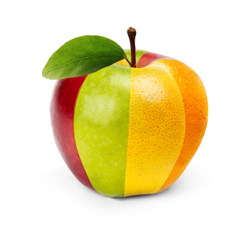Blog:
Can collaboration in publishing up revenue? Collab/Space forum surfaces insight

Can the diverse flavors of collaboration slice up and reconstitute a fuller revenue apple?

The Journalism Accelerator, MediaShift’s Collaboration Central, and the Investigative Reporting Project at UC Berkeley’s School of Journalism experimented with an extended conversation last month. A discussion about collaborating in journalism started among people face-to-face at a conference, then continued online with a sharpened focus on collaboration and revenue. There’s plenty to learn from the entire thread. This post identifies several major themes that emerged, setting the stage for a greater consideration of financial costs and benefits as journalists do more collaborations.
Journalist Carrie Lozano nailed a real need in her #1 takeaway from April’s “collaboration marathon” of back-to-back conferences in Berkeley. “We need to come up with useful cost-benefit analyses of collaboration,” she wrote on Collaboration Central last week.
That work is underway. Journalists and others experienced in collaboration began to assess the costs and benefits in a conversation that started at the Collab/Space 2012 conference, then continued online here at the Journalism Accelerator. The kickoff question focused on financial pros and cons, but people brought all sorts of costs and benefits into the discussion. Here are some highlights.
Benefits
Two major benefits of collaboration emerged from the JA conversation: exposure and the chance to try new things. For example, Steve Waldman cited collaborations between Beliefnet, the company he founded in 1999 and led for a decade, and ABC News. Beliefnet wasn’t paid for the content it gave ABC, and he says the link from the network site brought Beliefnet very little traffic. But, Waldman wrote, it did “enable us to class up our brand and improve the quality of our advertisers, and thereby fetch higher CPMs.”

Trevor Aaronson, co-director of the Florida Center for Investigative Reporting, says collaborations that show more people see FCIR’s stories puts his organization in a better position to win grant money. One example: a report on extraditions that was done with local NPR stations. Now FICR and a group of stations are applying for funding together. In addition, part of FICR’s mission is to do investigative reports that reach Spanish-speaking communities. “We can’t do that without collaborations,” Aaronson wrote in the JA forum, “and while we don’t generate direct revenue from these collaborations, we do believe [they] make our organization more attractive to foundations assisting with development in these communities.”
The opportunity to innovate appears to be another major draw of collaboration for journalists. These benefits aren’t clearly tested, but they’re tempting. Keith Hammonds of Ashoka mentioned a new pilot project with a national media organization that will link news stories to opportunities for readers to take action. Hammonds says this collaboration could create a stronger relationship between a news organization and its audience. “Readers who are activated by content to actually participate in change making activities should have higher loyalty and brand affiliation.”

Collaborations outside news organizations seem to have the potential to open doors wide for innovation. Ben Werdmuller, CTO at Latakoo, encourages partnering with one of the many consumer companies that specialize in reaching wide audiences, and making money through that reach. “If you’re producing long-form video journalism, for example, why not partner with Netflix or Hulu?” he wrote in the forum. A strategic partnership could “future-proof distribution strategies, while reaching new audiences and allowing you to concentrate on creating great content.”
And Michael Skoler, vice president of digital for Public Radio International suggests that collaborating with game creators might offer a chance at revenue while engaging people with news. “What if a game helped you question the tax assessment on your home? That might be something that you would pay for.” Another idea: pull education coverage together in a special report and collaborate with realtors to sell it. “I would pay for that when I move to a new place,” he wrote.
Being more efficient in administration, capitalizing on partners’ strengths, and improving the quality of reporting were also noted as potential benefits of collaboration. They are tempered by the realization that working together does take more time.
Costs
Time is the clearest cost of collaboration spelled out in the JA conversation. “Collaborations always mean more work,” wrote Trevor Aaronson, “more coordination, more emails, more egos, more cat-herding.” Media Consortium executive director Jo Ellen Green Kaiser says given the reduced capacity of many news organizations, it can be impossible to add that work to the routine daily load. “When more than 3 organizations collaborate,” she advises, “it’s most efficient to have an intermediary.”
Some advice on how to make collaborations work reveals real barriers to consider. For example: Pick a project manager from each collaboration partner and make sure they’re in regular contact. Establish a shared vision and shared goals early on. Make sure you like each other. And do think of the return: If this partnership won’t bring in money, what, specifically will it do?

The biggest cost of collaborating on content may be this: It may not move journalism closer to a new, sustainable financial model. Rick Waghorn, a former sports reporter, now a partner in the ad platform Addiply, wrote in the forum that journalists focused on collaborating with other journalists may not bring the financial gains the industry needs. ”We all suck at making bucks,” he says. “Making waves, fine. Bucks? No chance.”
So what next?
The lack of a direct line between collaboration and revenue means it might be smart to measure other results as well. It’s tough. Quantifying reach is perhaps the biggest challenge. New audiences have “tremendous value,” writes Trevor Aaronson. “But it’s hard for us tell you with specificity — and, as such, value it — the size and influence of the audience that hears our journalism on Florida NPR or reads it in the Miami Herald or in Spanish-language newspapers. It’s a key problem facing nonprofits like FCIR: How do you fully measure and value a fragmented audience on multiple platforms?”
PRI’s Skoler is in the middle of the State Integrity Investigation, a major collaboration among three organizations; two journalism, one policy. He says SII deliberately built in tools designed to measure impact, including how many people email state officials based on the information they learn from SII’s work, and how many reforms are introduced in state legislatures. “We have already seen actions taken in 5 states that cite the investigation,” he wrote, and are tracking such measures online.
Right now, the benefits of collaboration seem tangible to those who do it, if not always trackable. And the potential for revenue to be built in to collaboration is beginning to bubble up. There is plenty of room for sharing more experiences and continuing this collaborative conversation.
About Collab/Space 2012
Organized by MediaShift’s Collaboration Central and the Investigative Reporting Program at UC Berkeley’s Graduate School of Journalism, this daylong gathering in April brought together a range of journalists with different experience in collaboration to share insights and aspirations. Bundled with Techraking and the Logan Symposium, Collab/Space kicked off an intense conference week with a focus on collaboration.
A version of this post appeared on MediaShift’s Collaboration Central. Other related posts on the JA: Use case, the nuanced story behind the story of one successful collaboration. Resources, examples and practices to increase your yield from collaborative journalism. From the frontlines, takeaways from a live chat with two seasoned collaborators. Plus the forum itself, and as captured with Storify.










Weigh In: Remember to refresh often to see latest comments!
6 comments so far.
-
 Emily Harris says:
Emily Harris says:
May 23, 2012 at 5:21 pm
-
 Sally Duros says:
Sally Duros says:
May 22, 2012 at 1:54 pm
-
 Sally Duros says:
Sally Duros says:
May 22, 2012 at 1:55 pm
-
 WeLocally says:
WeLocally says:
May 22, 2012 at 11:08 am
-
 Michael Shapiro says:
Michael Shapiro says:
May 22, 2012 at 11:01 am
-
 Mike Green says:
Mike Green says:
May 20, 2012 at 9:50 am
| ParticipantsThanks so much to each of you for adding a lot more to this conversation! Mike, your question about whether splitting into niche sites may be splitting the revenue is fascinating – it seems like most conventional wisdom built up over the past few years points to go niche to attract a specific, dedicated audience. Sally, your point about competition in the newsroom is well taken! I’ve been in a few situations like that myself. We’re actively looking for examples of journalistic collaborations that do bring in revenue, or are created with that as a goal. So as you do that, or hear of any, please keep us posted!
HI Mike: I agree with much of what you say
You describe three news/ information providers that use different media to deliver information to a target “news” audience – investigative news.
By collaborating, they’re working together to make a bigger pie to attract a larger audience and collect the revenue streams attached to them. But undoubtedly the news providers will feel competitive when it comes to dividing up the “winnings,” i.e. any ad revenue, grant funding etc.
The hard work of collaboration is for each player to know honestly the added value they bring to the table. The hard work continues when the newsrooms come together to figure out the agreements/ rewards equation that works fairly.
Undoubtedly newsrooms aren’t accustomed to thinking collaboratively this way. In some newsrooms where I’ve worked, internal competition among the sections of the news “paper” was almost as bad as external competition.
more…..
Looking at what we discussed here on the JA, the impact of collaboration seems more clear than the process of successfully achieving it.
As described above in the blog post, some winnings from the bigger collaborative pie include : a better, more credible image; a larger audience; and cross-sector pollination resulting in innovation.
Those who are concerned about the time needed to successfully collaborate are perhaps not spending the necessary time upfront to define their added values and how that is tied to their take home piece of the pie. Collaborations will mean more time upfront, but not necessarily throughout. Since achieving anything is always a fluid work in progress, each iterative cycle of goal setting and implementation holds lessons and will require fine-tuning.
Also the work of a project manager in a collaboration is delicate but never dishonest. Although the impression you give and how you are perceived is important, projecting an image that misrepresents the capability of delivering as a partner will hurt your credibility. My favorite resource for analyzing collaborations like this is the book Co-Opetition, by Brandenburger and Nalebuff.
“Another idea: pull education coverage together in a special report and collaborate with realtors to sell it.”
Hey that’s a capital idea, and I do mean capital.
Getting the platform and mix together that lets the journalist report on the theme, and lets the local brand contribute sponsored content gives both parties a meaningful partnership in the community. To me this is the biggest missed opportunity for the indies, capitalise on the real one on one relationship with the local brands in a community and partner to provide a marketing partnership that CBS interactive cant compete with. This “high touch” info journalism/guide collaboration with local brands should not be considered an affront to journalistic integrity, its a new way to engage your readership with your community while supporting local. Its also super valuable to local brands.
Collaboration can be a wonderful win-win opportunity and has a good chance of indirectly contributing to increased revenue though a direct link is a bit harder to ascertain. At TheAlternativePress.com we partner with the Department of Community Programs in Summit, NJ to do an annual Cutest Baby photo contest. We supply the web platform, help to promote it, and secure sponsorships for it and the Department promotes it and encourages parents to participate. This year is our third year of doing it and it’s been a great vehicle for the Department to protect its aquatic facility and for our site to be read by even more people. And since readership impacts revenue, it could be helpful on that front, as well. Because of the success of this collaboration with Summit, we now have a similar program with two other towns we cover.
The drawback to collaboration is it takes time and for hyperlocal publishers, time is not something many of us have. But I think win-win collaboration like the one we have with Summit is worth the time and effort.
Collaboration in media will result in increased revenue when there’s diversity of experience, knowledge, expertise, vision and innovation among partners willing to experiment by developing new ideas brought to the table. This approach has to incorporate entrepreneurial principals, which is anathema to many journalists. Being risk-averse in an evolving economic climate filled with streams of disruptions in the market and upending of business models can be the most risky position.
The “news”paper has never been solely reliant upon its news sections to sell subscriptions and advertisements. The “news”paper is a coalescence of opinion, comics, weather, sports, entertainment, trends, fashion, books, gardening, garage sales, job hunting, education, trivia, history, politics, etc. When we take that collaboration of interests and split it up into niches on digital platforms catering to each audience, doesn’t that also split the revenues?
Revenue may be derived through a coalescence of behaviors of any target “news” audience by collaborating with relevant entities that have a vested interest. i.e. investigative news site & nonfiction publisher & documentary producer/cable channel..